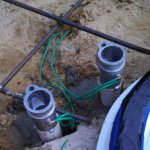I was reading the below post yesterday and thought my bonding could be bad; however, when I went back out to the pool after a few hours, I no longer felt that shock/sting on the open cuts/sores on my hands. What prompted me to search the threads is that I had just finished hosing off the filtration bags in my Desjoyaux pool and turned the pump back on when I stuck my hand in the water and felt the shock/sting. That was around 8:30 PM and when I went back out at 11:30 PM, I could no longer feel it. Is it because turning off the pump then turning it back on forced the voltage to balance out before no longer feeling the current or is something else happening?
I have not yet tightened down the bonding wire (which I assume is the bonding wire because it comes out of the ground and is a bare metal copper wire) but when I first opened the pool, I tightened it pretty good with tools. The only other thing I can think of is that instead of using the grounding terminal on the controller board of the Jandy variable speed ePump, I used the grounding screw that was fastened to the controller board housing unit.
Any help would be greatly appreciated.
Electrical shock from my pool water! - Page 2
I have not yet tightened down the bonding wire (which I assume is the bonding wire because it comes out of the ground and is a bare metal copper wire) but when I first opened the pool, I tightened it pretty good with tools. The only other thing I can think of is that instead of using the grounding terminal on the controller board of the Jandy variable speed ePump, I used the grounding screw that was fastened to the controller board housing unit.
Any help would be greatly appreciated.
Electrical shock from my pool water! - Page 2







